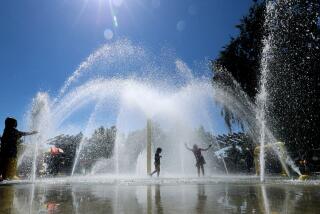Puzzled by Predictions? : Here’s a Barometer for Understanding Weather Terms
- Share via
If you associate a jet stream with a shower spray or a high pressure system with an ulcer, you’re not a weather ignoramus.
Many people are left in a fog by terms such as barometric pressure, El Nino, warm front and wind chill.
“Probably about 90% of the public hears all these terms, and all they gather in is whether it’s going to rain or be cold,” says James Murakami, a UCLA meteorologist.
“(KABC-TV’s) Dallas Raines said recently that a warm front is expected to bring rain and used a schematic to show what a warm front is. Whether the public took that in, I don’t know. It was only on screen for a few seconds.”
KNBC-TV weather caster Fritz Coleman agrees that many terms aren’t widely understood but says he can’t explain them in a brief broadcast.
“What people want to know is what to wear and how the weather will affect their day,” he says. “Is it going to be tough to drive through? Will their spouse be late coming home?
“My job is to be a communicator--to take relatively dry, scientific information and present it in a way that doesn’t make them tune out and gives them what they need to know.
“If people are concerned (about the terms), they will take time to be inquisitive.”
To save time, here are the meanings of some of the most-used weather words:
* Barometer: A device that measures the weight of air. Changes in air pressure cause mercury in a glass tube to rise and fall. Rising barometric pressure generally means sunshine, while a fall of pressure is linked with inclemency or storms.
* Jet stream: A narrow band of high-altitude, high-velocity wind often accompanied by a storm. The jet stream tends to lie in northern latitudes, reaching California only during winter.
* El Nino: Abnormally warm waters off the west coast of South America. Some researchers claim the condition affects weather patterns, but the correlation is ambiguous. One El Nino may produce drought while another causes floods.
* Front: An area between two air masses, one cold and one warm. When the masses interact to make the air between them rise, the motion promotes cooling and, frequently, formation of clouds. If the air cools sufficiently, condensation occurs, and enlarging water droplets create precipitation. Rain generally occurs at or near this frontal area.
High pressure system: Sinking air, which warms as it travels downward and doesn’t provide updrafts of air needed to create clouds. Highs are generally associated with sunshine.
* Low pressure system: Rising air that cools, forcing water vapor to change into droplets or clouds. With enough moisture, drops fall out of the clouds as rain or, if cold enough, snow.
* Santa Ana: A high pressure system that begins above the deserts--usually in Nevada, Utah and Idaho--and blows to the Los Angeles Basin. Because of the sinking motion of high pressure systems, the air is forced through canyon passes toward lower elevations, such as beaches. As the air is forced downward, it is warmed, generally resulting in warm, dry weather. These winds dry out the atmosphere and often carry pollen and spores from inland that irritate sinuses and allergies.
* Wind chill: A complex formula using wind speed and temperature determines this measure. It expresses how the body feels when heat generated by the body is blown away by wind.
* Wind direction: The direction from which the wind is blowing; i.e., a south wind blows from south to north. In a storm, a southerly wind is more favorable for rain.
* Chance of rain: The probability that measurable rain will fall anywhere in the forecast area during the forecast period.






